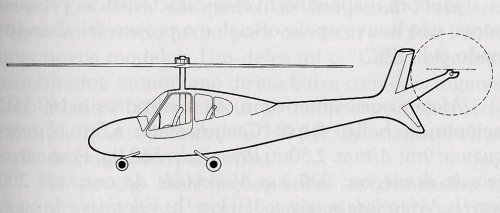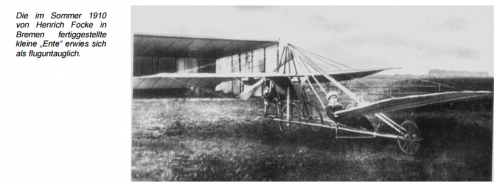- Joined
- 25 July 2007
- Messages
- 4,299
- Reaction score
- 4,193
Henrich Focke Aircraft Designations
Henrich Focke built at least one aircraft with his brother, Wilhelm Focke. The first powered design involving Henrich was the 1910 'Bremer Ente' ('Bremen Duck') canard aircraft (which proved too heavy to fly). [1] Henrich Focke then joined forces with Georg Wulf and Dr. Werner Naumann.
Early Focke-Wulf aircraft designs received works designations consisting of a role letter - A, F, GL, K, S, and W -- followed by a type number (which were assigned more or less consecutively). In pre-WWII publications, the type numbers are sometimes given in Roman numerals. This designation system was first used on the A 7 of 1921 and then applied retroactively to Focke's previous aircraft designs.
Alas, I do not know what the prefix letters stand for. It's tempting to suggest Austausch (Convertible), Flugzeug (Aircraft), Große Leichtflugzeug (Large Light aircraft), Kampf (Combat), Spezial (Special) ... or Schule or Sport ..., and Wasserflugzeug (Seaplane). But these are guesses only (although Wasser is a very safe guess).
Some sources display early Focke-Wulf designations with hyphens (eg: A-7), others without spaces (eg: A7). I have chosen to standard designations with a space (eg: A 7). A few Focke-Wulf designations numbers were non-consecutive (eg: the S 1 and S 2 trainers).
Sub-types were given a suffix letter. Until 1932, this suffix was a small letter. After 1932, suffixes were capital letters.
One anomaly is the S 39 reconnaissance monoplane. For no obvious reason this prototype is often referred to as the Focke-Wulf 39B. Ignoring the early capitalization, the omission of the role letter is odd. But the suffix is odder still since there doesn't seem to have ever been an 'S 39A' (unless this was an unknown, unbuilt project?). The S 39 is also sometimes dubbed the 'Fw 39' ... but that's jumping the gun.
The Focke-Wulf works system of designation continued until 1932 when it was replaced by a national numbering system (begun by the Heereswaffenamt, made mandatory in 1933 by the Reichsluftfahrtministerium (RLM). Under this system, Focke-Wulf Flugzeugbau GmbH was given the identifier code 'Fw' and assigned blocks of numbers.
While 'Fw 39' was not an RLM number, [2] Focke-Wulf was assigned '30' as 8-30 for the licensed Cierva C.30 autogyro ('8' being the RLM designator for powered aircraft). But the company doesn't seem to have taken this up -- there are 'Heuschrecke' ('Grasshopper') references to 'Fw C.30' (and even Fw C.19a) but 'Fw 30' seems to be a post-war rationalization.
To save space, I've used 'c/n' rather than 'WerkNr' for construction numbers.
Abbreviations include DVS for Deutsche Verkehrsflieger-Schule (German Civil Aviation Pilot Training Center).
'Missing' Focke-Wulf designations may cover licensed aircraft, eg: the Cierva C.19 autogyro; Albatros L75, L78, L101, and L102 variants (see Fw 55); and Heinkel HE 5 and HE 9 float monoplanes.
______________________________________________________
[1] The design was an evolution of Wilhelm Focke's 1909 'Ente' (built in the Potsdam workshop of Dr Edmund Rumpler). Henrich not involved in any way with the 1909 'Ente'.
[2] The RLM reserved the '39' number for DFS (applied to the 1935 Delta IV flying-wing).
______________________________________________________
Henrich Focke built at least one aircraft with his brother, Wilhelm Focke. The first powered design involving Henrich was the 1910 'Bremer Ente' ('Bremen Duck') canard aircraft (which proved too heavy to fly). [1] Henrich Focke then joined forces with Georg Wulf and Dr. Werner Naumann.
Early Focke-Wulf aircraft designs received works designations consisting of a role letter - A, F, GL, K, S, and W -- followed by a type number (which were assigned more or less consecutively). In pre-WWII publications, the type numbers are sometimes given in Roman numerals. This designation system was first used on the A 7 of 1921 and then applied retroactively to Focke's previous aircraft designs.
Alas, I do not know what the prefix letters stand for. It's tempting to suggest Austausch (Convertible), Flugzeug (Aircraft), Große Leichtflugzeug (Large Light aircraft), Kampf (Combat), Spezial (Special) ... or Schule or Sport ..., and Wasserflugzeug (Seaplane). But these are guesses only (although Wasser is a very safe guess).
Some sources display early Focke-Wulf designations with hyphens (eg: A-7), others without spaces (eg: A7). I have chosen to standard designations with a space (eg: A 7). A few Focke-Wulf designations numbers were non-consecutive (eg: the S 1 and S 2 trainers).
Sub-types were given a suffix letter. Until 1932, this suffix was a small letter. After 1932, suffixes were capital letters.
One anomaly is the S 39 reconnaissance monoplane. For no obvious reason this prototype is often referred to as the Focke-Wulf 39B. Ignoring the early capitalization, the omission of the role letter is odd. But the suffix is odder still since there doesn't seem to have ever been an 'S 39A' (unless this was an unknown, unbuilt project?). The S 39 is also sometimes dubbed the 'Fw 39' ... but that's jumping the gun.
The Focke-Wulf works system of designation continued until 1932 when it was replaced by a national numbering system (begun by the Heereswaffenamt, made mandatory in 1933 by the Reichsluftfahrtministerium (RLM). Under this system, Focke-Wulf Flugzeugbau GmbH was given the identifier code 'Fw' and assigned blocks of numbers.
While 'Fw 39' was not an RLM number, [2] Focke-Wulf was assigned '30' as 8-30 for the licensed Cierva C.30 autogyro ('8' being the RLM designator for powered aircraft). But the company doesn't seem to have taken this up -- there are 'Heuschrecke' ('Grasshopper') references to 'Fw C.30' (and even Fw C.19a) but 'Fw 30' seems to be a post-war rationalization.
To save space, I've used 'c/n' rather than 'WerkNr' for construction numbers.
Abbreviations include DVS for Deutsche Verkehrsflieger-Schule (German Civil Aviation Pilot Training Center).
'Missing' Focke-Wulf designations may cover licensed aircraft, eg: the Cierva C.19 autogyro; Albatros L75, L78, L101, and L102 variants (see Fw 55); and Heinkel HE 5 and HE 9 float monoplanes.
______________________________________________________
[1] The design was an evolution of Wilhelm Focke's 1909 'Ente' (built in the Potsdam workshop of Dr Edmund Rumpler). Henrich not involved in any way with the 1909 'Ente'.
[2] The RLM reserved the '39' number for DFS (applied to the 1935 Delta IV flying-wing).
______________________________________________________



